
The United States Capitol, often called the Capitol or the Capitol Building, is the seat of the United States Congress, the legislative branch of the federal government. It is located on Capitol Hill at the eastern end of the National Mall in Washington, D.C. Although no longer at the geographic center of the national capital, the U.S. Capitol forms the origin point for the street-numbering system of the district as well as its four quadrants. Like the principal buildings of the executive and judicial branches, the Capitol is built in a neoclassical style and has a white exterior.
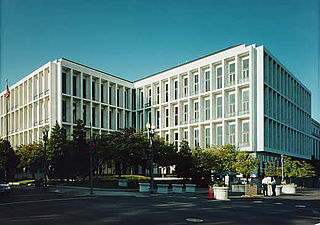
The Philip A. Hart Senate Office Building is the third U.S. Senate office building, and is located on 2nd Street NE between Constitution Avenue NE and C Street NE, northeast of the United States Capitol in Washington, D.C., in the United States. Construction began in January 1975, and it was first occupied in November 1982. Rapidly rising construction costs plagued the building, creating several unfortunate scandals. The structure is named for Philip A. Hart (1912-1976), who served 18 years as a United States Senator from Michigan. Accessed via a spur of the United States Capitol Subway System, the building features a nine-story atrium dominated by massive artwork, and a large Central Hearing Facility which provides television facilities as well as extensive seating.

The National Statuary Hall is a chamber in the United States Capitol devoted to sculptures of prominent Americans. The hall, also known as the Old Hall of the House, is a large, two-story, semicircular room with a second story gallery along the curved perimeter. It is located immediately south of the Rotunda. The meeting place of the U.S. House of Representatives for nearly 50 years (1807–1857), after a few years of disuse it was repurposed as a statuary hall in 1864; this is when the National Statuary Hall Collection was established. By 1933, the collection had outgrown this single room, and a number of statues are placed elsewhere within the Capitol.

Nicholas Longworth III was an American lawyer and politician who became Speaker of the United States House of Representatives. A Republican, he was elected to the Ohio Senate, where he initiated the successful Longworth Act of 1902, regulating the issuance of municipal bonds. As congressman for Ohio's 1st congressional district, he soon became a popular social figure of Washington, and married President Theodore Roosevelt's daughter Alice Lee. Their relationship became strained when he opposed her father in the Republican Party split of 1912. Longworth became Majority Leader of the House in 1923, and Speaker from 1925 to 1931. In this post, he exercised powerful leadership, tempered by charm and tact.
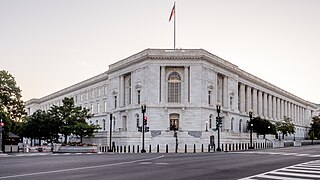
The Russell Senate Office Building is the oldest of the United States Senate office buildings. Designed in the Beaux-Arts architectural style, it was built from 1903 to 1908 and opened in 1909. It was named for former Senator Richard Russell Jr. from Georgia in 1972. It occupies a site north of the Capitol bounded by Constitution Avenue, First Street, Delaware Avenue, and C Street N.E.

The Architect of the Capitol is the federal agency responsible for the maintenance, operation, development, and preservation of the United States Capitol Complex. It is an agency of the legislative branch of the federal government and is accountable to the United States Congress and the Supreme Court. Both the agency and the head of the agency are called "Architect of the Capitol". The head of the agency is appointed by a vote of a congressional commission for a ten-year term. Prior to 2024, the president of the United States appointed the Architect upon confirmation vote by the United States Senate, and was accountable to the president.

The Cannon House Office Building, often called the "Old House Office Building", completed in 1908, is the oldest office building of the United States Congress in Washington, D.C. A significant example of the Beaux-Arts style of architecture, it occupies a site south of the United States Capitol bounded by Independence Avenue, First Street, New Jersey Avenue, and C Street S.E. In 1962 the building was named for former Speaker of the United States House of Representatives Joseph Gurney Cannon.

The Dirksen Senate Office Building is the second office building constructed for members and staff of the United States Senate, northeast of the United States Capitol, in Washington, D.C., and was named for the late longtime Minority Leader Everett Dirksen from Illinois in 1972.

The Rayburn House Office Building (RHOB) is a congressional office building for the U.S. House of Representatives in the Capitol Hill neighborhood of Washington, D.C., between South Capitol Street and First Street.
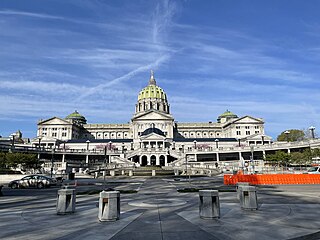
The Pennsylvania State Capitol is the seat of government for the U.S. state of Pennsylvania located in downtown Harrisburg. The building was designed by architect Joseph Miller Huston in 1902 and completed in 1906 in a Beaux-Arts style with decorative Renaissance themes throughout. The capitol houses the legislative chambers for the Pennsylvania General Assembly, made up of the House of Representatives and the Senate, and the Harrisburg chambers for the Supreme and Superior Courts of Pennsylvania, as well as the offices of the Governor and the Lieutenant Governor. It is also the main building of the Pennsylvania State Capitol Complex.

The United States Capitol Complex is a group of twenty buildings, grounds, and facilities in Washington, D.C., that are used by the United States Congress, and federal courts. The buildings and grounds within the complex are managed and supervised by the Architect of the Capitol.

The Idaho State Capitol in Boise is the home of the government of the U.S. state of Idaho. Although Lewiston briefly served as Idaho's capital city from the formation of the old federal Idaho Territory in 1863, the territorial legislature moved it to Boise on December 24, 1864. It continued as such following the admission of the Territory as the 43rd state in the federal Union on July 3, 1890, the day before Independence Day, the Fourth of July, when a 43rd white star was added officially to the constellation in the upper corner blue field (canton) of the red and white striped American Flag.

The James Madison Memorial Building is one of three United States Capitol Complex buildings that house the Library of Congress. The building was constructed from 1971 to 1976, and serves as the official memorial to United States Founding Father and president James Madison. It is located between First and Second Streets SE on Independence Avenue, across from the main library Thomas Jefferson Building, in Washington, D.C. In addition to various book and multimedia collections, it houses the United States Copyright Office, which is under the administration of the Librarian of Congress.

The Mississippi State Capitol or the “New Capitol,” has been the seat of the state’s government since it succeeded the old Mississippi State House in 1903. Located in the centrally-located state capital / capital city of Jackson, in Hinds County, it was designated as a Mississippi Landmark in 1986, and subsequently a National Historic Landmark in 2016 and earlier added to the National Register of Historic Places in 1969,.
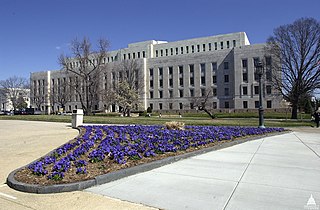
The John Adams Building is the second oldest of the buildings of the Library of Congress of the United States. Built in the 1930s, it is named for John Adams, the second president, who signed the law creating the Library of Congress in 1800. The building is in the Capitol Hill district of Washington D.C. next to the library's main building in the Capitol Complex. The Adams building opened to the public on April 5, 1939, and before being named for the president in 1980, was simply called The Annex building. It is designed in a restrained but very detailed Art Deco style and faced in white Georgia marble. It is located on Second Street SE between Independence Avenue and East Capitol Street in Washington, DC.
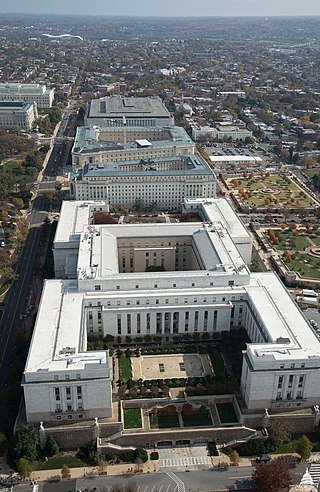
The congressional office buildings are the office buildings used by the United States Congress to augment the limited space in the United States Capitol. The congressional office buildings are part of the Capitol Complex, and are thus under the authority of the Architect of the Capitol and protected by the United States Capitol Police. The office buildings house the individual offices of each U.S. Representative and Senator as well as committee hearing rooms, staff rooms, multiple cafeterias, and areas for support, committee, and maintenance staff.

The United States Capitol building features a central rotunda below the Capitol dome. Built between 1818 and 1824, the rotunda has been described as the Capitol's "symbolic and physical heart".
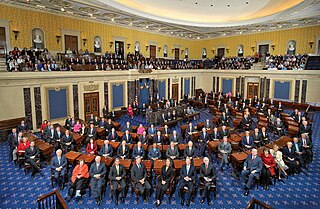
The United States Senate Chamber is a room in the north wing of the United States Capitol that has served as the legislative chamber of the United States Senate, since January 4, 1859. The Senate first convened in its current meeting place after utilizing Federal Hall, Congress Hall, and the Old Senate Chamber in the Capitol building for the same purpose.

The O'Neill House Office Building is an office building in Washington, D.C., that houses offices of both the House of Representatives and the U.S. Department of Health and Human Services. It is named after former United States Representative (congressman) from Massachusetts and Speaker of the United States House of Representatives Thomas P. "Tip" O'Neill Jr. (1912-1994), and located at 200 C Street Southwest in the Southwest Federal Center district, at the foot of Capitol Hill.
The House Beauty Shop Committee was a special committee of the United States House of Representatives which existed from 1967 to 1979. It was initially established pursuant to H.Res. 1000 and introduced by Representative Martha Griffiths, a Democrat representing Michigan's 17th district. Griffiths, along with Edith Green and Catherine May, became the first members of the committee. It was formed to oversee and modernize the operations of the House Beauty Shop, a beauty salon located in the Cannon House Office Building in the United States Capitol.






















